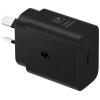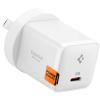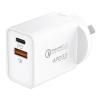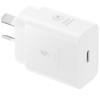Fast charging has become a standard feature in modern phones, tablets, and other devices, but it often comes with unfamiliar terms. Two of the most common are PD (Power Delivery) and QC (Quick Charge). While both aim to charge your devices faster, they are not the same, and understanding the difference can help you choose the right charger or cable for your needs.
What Is PD (Power Delivery)?
Power Delivery is a fast charging standard developed by the USB-IF, the same group that manages the USB standard. It is designed to deliver higher levels of power over a USB connection, and it works primarily over USB-C ports.
PD is widely supported across a range of devices, including Android phones, tablets, laptops, and accessories like power banks and USB-C hubs. It is a universal standard, which means it is not tied to any single brand or device type.
PD charging can deliver anywhere from 18 watts up to 240 watts of power, depending on the charger, cable, and device. This makes it suitable not just for phones, but also for larger devices like laptops and monitors that require more power.
What Is QC (Quick Charge)?
Quick Charge is a fast charging technology developed by Qualcomm, the company behind many smartphone processors. It is designed to work primarily with Snapdragon-powered Android devices and is often found in older USB-A chargers.
QC focuses on increasing voltage to speed up charging without requiring high currents. For example, instead of 5V at 3A like some PD options, QC might offer 9V at 2A or 12V at 1.5A. This allows faster charging with cables and ports that do not support USB-C.
There are multiple versions of Quick Charge, including QC 2.0, 3.0, 4.0, and 5.0. Newer versions have improved speed and efficiency, but the level of support varies between devices.
Key Differences Between PD and QC
Here is how PD and QC differ in practical terms:
- Compatibility
- PD is more widely compatible, especially with USB-C devices
- QC is mainly used in Android phones with Qualcomm Snapdragon chips
- Some phones support both, but not all do
- Charging Method
- PD increases both voltage and current depending on what the device supports
- QC mostly increases voltage and relies on Qualcomm-specific technology
- Port and Cable Type
- PD typically uses USB-C to USB-C connections
- QC often uses USB-A to USB-C cables, although newer versions can work with USB-C as well
- Power Output
- PD can provide more power overall, up to 240W in its latest version
- QC is typically limited to around 100W in its most advanced form
- Brand Dependence
- PD is open and supported across many brands
QC is a proprietary standard mainly used in Qualcomm-powered devices.

Do You Need PD or QC?
It depends on what you are charging.
If you are charging a USB-C phone, tablet, or laptop, PD is usually the better option. It is more future proof, supports higher power delivery, and is compatible with a wide range of devices.
If you are charging an older Android phone or a device that specifically supports Quick Charge, a QC-compatible charger can still provide excellent speed and performance.
Some chargers now support both standards, which is ideal if you have a mix of devices at home.
Can You Use One for the Other?
In many cases, yes. A PD charger can charge a QC-compatible device, and vice versa, but the device may fall back to regular or slower charging if the protocol is not supported.
For example, if you plug a QC-only phone into a PD charger, it may still charge, but not at full speed. Likewise, using a PD-compatible laptop with a QC charger may not work at all if the power output is too low.
Checking your device’s supported charging protocols is the best way to ensure compatibility and performance.
Final Thoughts
PD and QC are both fast charging standards, but they use different technologies and serve slightly different purposes. PD is more flexible and better suited to newer USB-C devices, while QC still plays a role in many Android phones that use Qualcomm chipsets.
When choosing a charger, look for one that supports the standard your device is built for. If you want one charger that can handle everything, consider a model that supports both PD and QC, so you can charge phones, tablets, laptops, and accessories without switching plugs.
Understanding these terms makes it easier to choose the right gear and avoid slow charging speeds or compatibility issues down the line.







